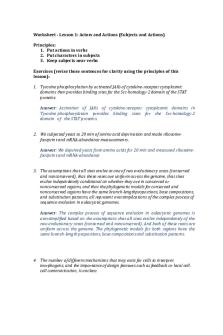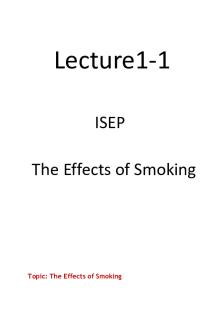Duke Writing lesson 1-Answer PDF

| Title | Duke Writing lesson 1-Answer |
|---|---|
| Author | Salekin Mishu |
| Course | Research Methodology |
| Institution | Ahsanullah University of Science and Technology |
| Pages | 2 |
| File Size | 45.5 KB |
| File Type | |
| Total Downloads | 89 |
| Total Views | 158 |
Summary
Download Duke Writing lesson 1-Answer PDF
Description
Worksheet - Lesson 1: Actors and Actions (Subjects and Actions) Principles: 1. Put actions in verbs 2. Put characters in subjects 3. Keep subjects near verbs Exercises (revise these sentences for clarity using the principles of this lesson): 1. Tyrosine phosphorylation by activated JAKs of cytokine-receptor cytoplasmic domains then provides binding sites for the Src-homology-2 domain of the STAT proteins. Answer: Activation of JAKs of cytokine-receptor cytoplasmic domains in Tyrosine phosphorylation provides binding sites for the Src-homology-2 domain of the STAT proteins.
2. We subjected yeast to 20 min of amino acid deprivation and made ribosomefootprint and mRNA-abundance measurements. Answer: We deprived yeast from amino acids for 20 min and measured ribosomefootprint and mRNA-abundance
3. The assumptions that all sites evolve at one of two evolutionary rates (conserved and nonconserved), that these rates are uniform across the genome, that sites evolve independently conditional on whether they are in conserved or nonconserved regions, and that the phylogenetic models for conserved and nonconserved regions have the same branch-lengthproportions, base compositions, and substitution patterns, all represent oversimplications of the complex process of sequence evolution in eukaryotic genomes. Answer: The complex process of sequence evolution in eukaryotic genomes is oversimplified based on the assumptions that all sites evolve independently of the two evolutionary rates (conserved and nonconserved). And both of these rates are uniform across the genome. The phylogenetic models for both regions have the same branch-length proportions, base compositions and substitution patterns.
4. The number of different mechanisms that may exist for cells to interpret morphogens, and the importance of design features such as feedback or local cellcell communication, is unclear.
Answer: The number of mechanisms that cells use to interpret morphogens and the importance of design features such as feedback or local cell-cell communication. 5. Furthermore, the application of new technologies to further understand the biology of the adipocyte, including location analysis, global DNase hypersensitivity, highthroughput RNA-interference screens and computational strategies, promises to enhance our knowledge of this once-neglected cell. Answer: Applying new technologies to further understand the biology of adipocytes will enhance our knowledge of this once neglected cell. 6. Indeed, in the mouse, the sequences of large noncoding RNAs, which probably have no 3' polyA tail, were reconstructed from the fragments of truncated cDNAs. Answer: Reconstructing the sequences of large noncoding RNAs in the mouse, which probably have no 3’ polyA tail, from the fragments of truncated cDNAs. 7. Localized fluctuations in substitution rate are widely employed to draw inference concerning the phenotypic significance of genomic sequence. Answer: The phenotypic significance of genomic sequence is inferred form localized fluctuations in substitution rate. 8. A number of promoters exhibited significant positive correlations between the footprinting estimated distribution of K and nucleosome score estimated from TCells. Answer: Estimated footprinting distribution of K and nucleosome score estimated from T-Cells exhibited significant positive correlations. 9. In this study, we subjected seven different primate species to comparative analysis of the radial distribution pattern of human chromosome 18- and 19-homologous chromatin by three-dimensional fluorescence in situ hybridization. Answer: In this study, seven different primate species were compared using threedimensional fluorescence in situ hybridization based on radial distribution pattern of human chromosome 18- and 19-homologous chromatin....
Similar Free PDFs

Duke Writing lesson 1-Answer
- 2 Pages

Duke Writing lesson 2-Answer
- 2 Pages
Popular Institutions
- Tinajero National High School - Annex
- Politeknik Caltex Riau
- Yokohama City University
- SGT University
- University of Al-Qadisiyah
- Divine Word College of Vigan
- Techniek College Rotterdam
- Universidade de Santiago
- Universiti Teknologi MARA Cawangan Johor Kampus Pasir Gudang
- Poltekkes Kemenkes Yogyakarta
- Baguio City National High School
- Colegio san marcos
- preparatoria uno
- Centro de Bachillerato Tecnológico Industrial y de Servicios No. 107
- Dalian Maritime University
- Quang Trung Secondary School
- Colegio Tecnológico en Informática
- Corporación Regional de Educación Superior
- Grupo CEDVA
- Dar Al Uloom University
- Centro de Estudios Preuniversitarios de la Universidad Nacional de Ingeniería
- 上智大学
- Aakash International School, Nuna Majara
- San Felipe Neri Catholic School
- Kang Chiao International School - New Taipei City
- Misamis Occidental National High School
- Institución Educativa Escuela Normal Juan Ladrilleros
- Kolehiyo ng Pantukan
- Batanes State College
- Instituto Continental
- Sekolah Menengah Kejuruan Kesehatan Kaltara (Tarakan)
- Colegio de La Inmaculada Concepcion - Cebu













